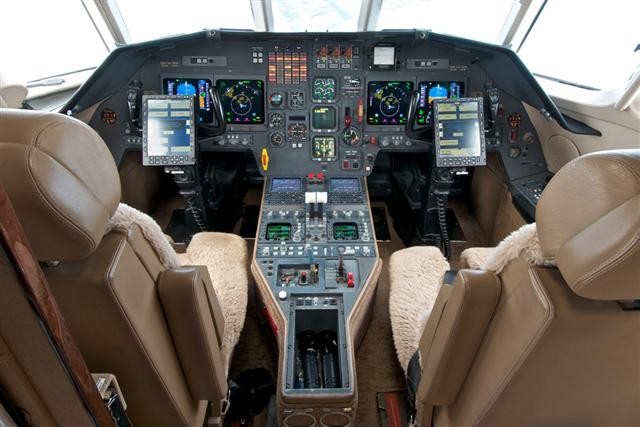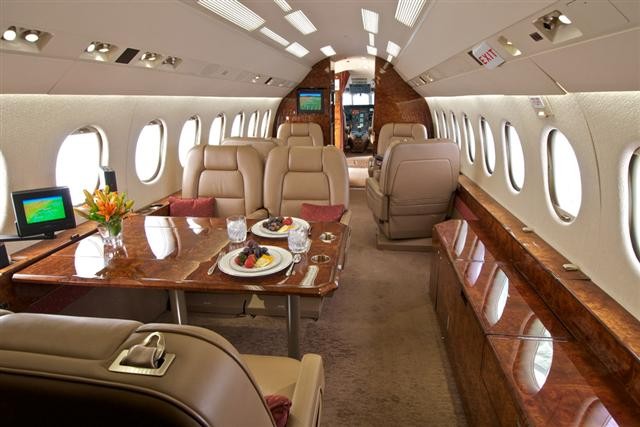


Aircraft Description
Background/History
Following the success of its DA-900 series three-engine intercontinental jets, Dassault announced the development of a wide-body jet of shorter range to replace its aging Falcon 20/200 line. The Falcon 2000 is essentially a reduced size, twin-engine derivative of the Falcon 900 series. The 2000 borrows the 900’s wide fuselage, although it is shortened by about 6 ft. The wing is the same one that was originally designed for the Falcon 50 tri-jet, and has been used on the 900-series and now the 2000 with only minor modifications. The engine used on the Falcon 2000 is a new design, the CFE738 developed jointly by General Electric and AlliedSignal. First flight of the Falcon 2000 occurred in March 1993 and FAA certification was granted in February 1995. Over 229 aircraft have been produced through the end of 2006.
Power
The Falcon 2000 is powered by two CFE738-1-1B axial-centrifugal flow turbofan engines rated at 5,918 lbs. of thrust each at ISA +15C. The engines are controlled by dual FADECs and engine parameters are displayed on three LCD EIECs. Inspection interval on the engines is 6,000 hours.
Avionics
The Falcon 2000 is typically equipped with the Collins EFIS 4000 system with four large screens, dual Collins ADC 850 digital air data computers, dual Collins FMS 6100 flight management systems, APS 4000 auto-pilot system, Honeywell Laseref III IRS, Collins TWR850 weather radar system, Sextant 3-tube EIEDs and Collins ALT55B radar altimeter. Also standard is the Collins Proline 4 Arinc 429 radio comm/nav system. Other equipment includes a Collins HF 9000 high requency radio, Allied Signal EGPWS and CVR and an ELT. Optional is the Flight Dynamics HGS 2850 head-up display.
Design Features
The Falcon 2000 is a long range, twin-turbofan powered business aircraft configured as a cantilever, swept low-wing monoplane with a swept cruciform tail. The aft-fuselage section incorporates area-ruling. The wing employs a supercritical airfoil and is essentially the same as that used on the Falcon 50, but with a span increase of 1.5 ft. The wing has retained its relative simplicity, devoid of winglets, fences, or vortex generators. The retractable tricycle landing gear has dual wheels on each unit and is electrically controlled and hydraulically actuated. The landing gear’s carbon disc brakes are powered by two hydraulic systems. One system incorporates an anti-skid system. The 28-volt DC electrical system utilizes two engine-driven rectifier-alternators to supply power in flight to the three independent bus bars.
Accomodations
The Falcon 2000 is certificated for as many as nineteen passengers, although the standard interior configuration is for eight passengers. Like its Falcon 900-series cousins, the Falcon 2000 has a cabin wide enough to seat three abreast with an aisle and is normally divided into forward and rear lounge areas with club seating in each area. Cabin volume is greater than 1,000 cu. ft., which includes a stand-up lavatory and a large 134 cu.ft. baggage compartment that is accessable in flight. Cabin height is a comfortable 6.1 ft., width is 7.7 ft. and length is 26.3ft.
| General | Falcon 2000, DA2000 | |||
|---|---|---|---|---|
| Category | Jet < 20,000 lbs. | |||
| Years Aircraft Manufactured | 1995 – 2006 | |||
| Serial Number Range | 0001-0220 (up) | |||
| Retail High Price | $13,250,000.00 / 10,397,275.00€ | |||
| Retail Low Price | $8,400,000.00 / 6,591,480.00€ | |||
| Characteristics | Falcon 2000, DA2000 | |||
| Seating | 2+8/19 | |||
| Wing Loading | 67.9 | |||
| Power Loading | 3.0 | |||
| Noise(EPNdB): Takeoff/Sideline/Approach | 79.4/86.4/93.1 | |||
| External Dimensions (ft) | Falcon 2000, DA2000 | |||
| External Length | 66.3 | |||
| External Height | 23.2 | |||
| External Span | 63.4 | |||
| Internal Dimensions (ft) | Falcon 2000, DA2000 | |||
| Internal Length (Overall/Net Height) | 31.2/26.3 | |||
| Internal Height | 6.2 | |||
| Internal Width (Max/Floor) | 7.7/6.3 | |||
| Baggage | Falcon 2000, DA2000 | |||
| External: Cu.Ft./Lb. | 134/1,587 | |||
| External: Cu.Ft./Lb. | N/A | |||
| Power | Falcon 2000, DA2000 | |||
| Engines | 2 CFE 738-1-1B | |||
| Output (lbs ea.)/Flat Rating | 5,918/ISA+15 | |||
| Inspection Interval | 6,000c | |||
| Data based on latest manufactured year | ||||



